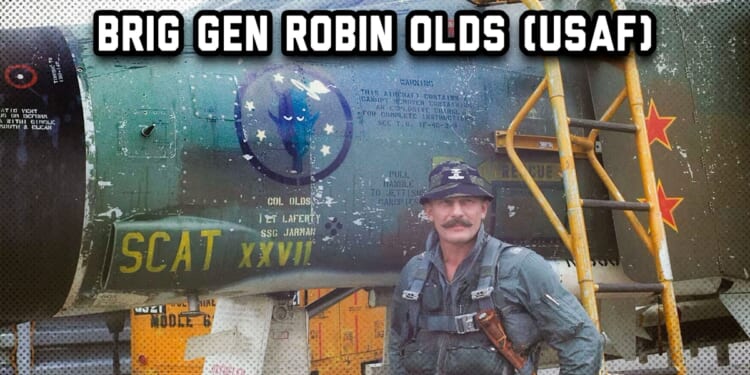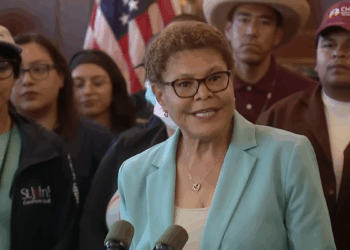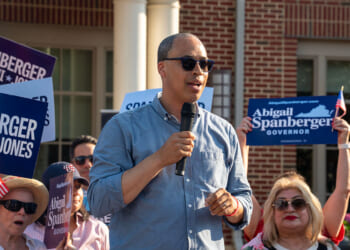Robin Olds was born in Honolulu, Hawaii, but spent most of his youth in Hampton (Langley Field), Virginia. He was the son of Army Air Force aviator Robert Olds, a pursuit pilot in World War I and an aide to Brig. Gen. Billy Mitchel. Robert would also command the first B-17 squadron in World War II and ultimately retire as a Major General. Robin’s mother, Eloise, died when he was just four, and he was raised by his father and stepmother.
Robin’s earliest memories were of the sight and sounds of military aircraft, and he took his first flight at age eight in a trainer piloted by his father. He was hooked, and by the age of 12, was determined to attend the U.S. Military Academy at West Point to become an Army aviator. In high school, he was elected president of his class three years in a row and was an accomplished football player. He spurned offers from Virginia Military Institute and Dartmouth College to attend West Point and entered the Class of 1944.
After the attack on Pearl Harbor, he left the USMA briefly for flight training, then returned to West Point, where he excelled in academics, was an All-American tackle, and graduated a year ahead of his class in 1943. That was also the year of his father’s death.
Having completed his basic and advanced training at Stewart Field prior to graduation, he received his wings personally from Gen Hap Arnold on May 30, 1943. He then completed training with the 329th Fighter Group and would become a Lockheed P-38 Lightning fighter pilot. Before deployment to Europe, he had logged 650 hours, including 250 hours in the P-38.
In May 1944, Olds deployed with the 479th Fighter Group and quickly transitioned into combat roles in support of the D-Day Invasion at Normandy. A month later, then Capt Olds became a squadron leader, and in August, flying “Scat II,” he shot down a pair of Focke-Wulf 190s — his first kills. A week after that encounter, he shot down three Messerschmitt Bf 109s, one when he was flying dead stick because, in the battle fog, he had forgotten to switch to external tanks and both engines quit.
On the second engagement with the Messerschmitts, in a deep dive pursuit at about 500 mph, after hitting his mark, he recalled narrowly surviving the G-forces: “I managed to pull out, right above this wheat field near the town of Rostock. After that, I had had enough, I was ready to go home.” But then, seeing machine gun tracers across his nose from another 109, he pulled a stall maneuver to get behind the enemy plane and took him out.
Five kills made him an ace and the top-scoring P-38 pilot of the European Theater.
In September 1944, the 479th FG transitioned to the formidable P-51 Mustang. In October, flying his “Scat VI,” Olds shot down another Fw 190 and completed his first combat tour in November, accruing 270 combat flight hours. After two months leave in the U.S., Olds returned to the 434th Fighter Squadron, and on 09 February 1945, the day he was promoted to Major, he shot down his seventh German fighter. Five days later, he scored three more kills, two Bf 109s and an Fw 190, though one of the kills was only credited as a probable.
In March 1945, at age 22 and not yet two years out of West Point, he was made Squadron Commander. In April, he shot down his last fighter while flying escort for B-24s, another BF 109.
By the end of World War II in May, he was credited with downing 12 German fighters and destroying 11 others on the ground in strafing runs. He was the only pilot to make Ace in both his P-38 (5 victories) and his P-51 (8 victories), and would be the recipient of two Silver Stars for his actions.
In the 20 years between World War II and Vietnam, Olds held various stateside commands and continued to prove himself an outstanding commander and pilot.
In September 1966, he was selected as commander of the 8th Tactical Fighter Wing’s F-4C Phantoms, based at Ubon Royal Thai Air Force Base. The then-44-year-old Colonel, inspired aggressive confidence, “leading from the front” in those flying with him, in what was now his “Scat XXVII.”
In a daring mission in January 1967, Olds and his “Wolfpack Wing” squadron intentionally lured MiG-21s into a fight from a forward base, and they shot down seven of the MiGs, Robin scoring one. Leading that mission, codenamed Operation Bolo, in what was the biggest air battle of the Vietnam War, earned him another Silver Star. He would earn his fourth Silver Star leading a low-level bombing strike in March.
In May of that year, he shot down three more MiGs, one of which had shot down his wingman. His dogfight with that enemy pilot was described by one of his fellow squadron pilots as a “vengeful chase.”
In August, he earned the Air Force Cross, the second-highest military decoration, after the Medal of Honor, for his critical attack on the Paul Doumer Bridge in Hanoi. The “Wolfpack” became the top MiG-killing Wing in Southeast Asia.
His citation notes in part:
Colonel Olds led his strike force of eight F-4C aircraft against a key railroad and highway bridge in North Vietnam. Despite intense, accurately directed fire, multiple surface-to-air missile attacks on his force, and continuous harassment by MiG fighters defending the target, Colonel Olds, with undaunted determination, indomitable courage, and professional skill, led his force through to help destroy this significant bridge. As a result the flow of war materials into this area was appreciably reduced. Through his extraordinary heroism, superb airmanship, and aggressiveness in the face of hostile forces, Colonel Olds reflected the highest credit upon himself and the United States Air Force.
Old’s final combat mission was a month later, bringing his total number of missions to 107 in World War II and 152 in Southeast Asia — 105 of which were over North Vietnam.
After Vietnam, Olds served as Commandant of Cadets at the Air Force Academy and ended his career as Director of Aerospace Safety for the Air Force.
You can watch a narrative of his biography here.
Brig Gen Robin Olds: Your example of valor — a humble American Patriot defending Liberty for all above and beyond the call of duty — is eternal.
“Greater love has no one than this, to lay down one’s life for his friends.” (John 15:13)
Live your life worthy of his sacrifice.
(Read more Profiles of Valor here.)
Semper Vigilans Fortis Paratus et Fidelis
Pro Deo et Libertate — 1776
Follow Mark Alexander on X/Twitter.
Join us in daily prayer for our Patriots in uniform standing in harm’s way in defense of American Liberty, and for the families awaiting their safe return. Pray also for our Veterans, First Responders, and their families.
The Patriot Post and Patriot Foundation Trust, in keeping with our our Military Mission of Service to our uniformed service members and veterans, are proud to support and promote the National Medal of Honor Heritage Center, the Congressional Medal of Honor Society, both Honoring Their Sacrifice Foundation and Warrior Freedom Service Dogs aiding wounded veterans, Tunnel to Towers Foundation, the National Veterans Entrepreneurship Program, the Folds of Honor outreach and Officer Christian Fellowship, the Air University Foundation and Naval War College Foundation, and the Naval Aviation Museum Foundation.















